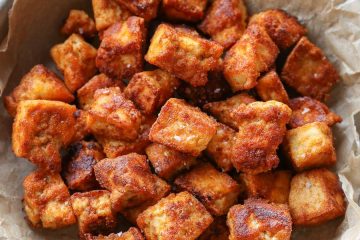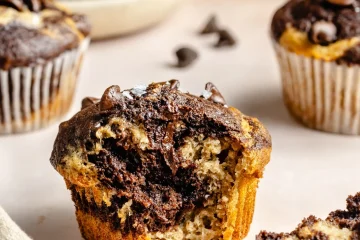Ah, Pad Thai. When the craving hits, it’s like a siren call from the bustling street markets of Thailand.
That savory, tangy, sweet, and often spicy flavor is hard to resist, especially after a long day when cooking is the last thing you want to do. Just a quick call to the local Thai restaurant, and the takeout container of deliciousness is on its way in no time at all.
But here’s the burning question (and we’re not talking about the red pepper flakes): Is Pad Thai healthy?

With noodles drenched in sodium-rich sauces and often topped with crushed peanuts, it makes sense that Pad Thai is one of the most delicious dishes out there. But if you’re watching your weight or trying to keep your calories in check, is Pad Thai a good option?
While you simply cannot beat takeout from a Thai restaurant, making your own healthier Pad Thai at home is actually very simple!
In this post I’m going to explore what makes Pad Thai so special, but more importantly, we’re going to dive into our own healthy Pad Thai recipe. So, grab your chopsticks (or fork, no judgment here…I actually don’t know how to use chopsticks), and let’s dive into the delicious world of Pad Thai.
What Exactly is Pad Thai?
Pad Thai might seem like a fancy dish if you’ve never had it before, but it’s a surprisingly delicious one.
At its core, Pad Thai is a stir-fried noodle dish that combines sweet, savory, tangy, and spicy flavors all in one dish.
Imagine slurping up soft rice noodles coated with a tangy tamarind paste and soy sauce blend. Add to that a generous sprinkle of brown sugar or honey, a squeeze of lime, and a hint of chili paste for a little kick.
Then, there’s the crunch of fresh bean sprouts, bell peppers, and the rich taste of scrambled eggs. Every bite is a delightful mix of sweet, sour, salty, and spicy.
What sets Pad Thai apart from your run-of-the-mill stir fry? It’s the perfect combination of simple ingredients, coming together in a large skillet to create something extraordinary.
- Rice Noodles: Soft and chewy, these noodles soak up the flavors like a sponge, adding that authentic Pad Thai touch.
- Sauces and Spices: Tamarind paste, fish sauce, and chili paste join forces with lemon or lime juice, creating a flavor-packed small bowl of magic. Tamarind paste is not the most common of ingredients, so our healthy recipe is actually going to do without that- more on that in a minute.
- Vegetables and Protein: With a base of bell pepper, onion, carrots, and bean sprouts, you get a delightful crunch and a boost of micronutrients. Add your favorite lean protein like chicken thighs, chicken breast, or shrimp, and you’ve got a well-rounded and protein-packed meal.
- Peanutty Goodness: Pad Thai includes peanut butter in the sauce, giving it a richness and subtle sweetness. When the salty crushed peanuts are added on top, this dish becomes a peanut lover’s dream meal.
Calories in Traditional Pad Thai
When ordering Pad Thai from a Thai restaurant, it’s not unusual to find servings that feed 2-3 people in one takeout container. If you’ve ever finished a takeout container all to yourself, you know all too well that it leaves you feeling incredibly full.
While the exact calories in Pad Thai can vary widely based on the Thai restaurant, here’s a general idea:
- Single serving: Roughly 600-800 calories
- Takeout container: 1200-1800 calories (usually 2-3 servings)
- Macros: Carbs: 80-100g, Protein: 20-30g, Fat: 15-20g (per serving)
- Sodium: Around 1500-2000mg per serving
Is Pad Thai healthy? Well, we all define healthy differently, but it’s clear that Pad Thai can be a very calorically dense dish, especially when ordering takeout. Does that make it unhealthy? No, not necessarily.
But if you want a healthier twist on this classic dish, let’s break down how you make your own healthy Pad Thai at home (in just 20 minutes).
How to Make Your Own Healthy Pad Thai
Ready to bring the flavors of your favorite Thai restaurant home, but with far fewer calories? This Healthy Pad Thai is a meal prep game-changer.
To start, we’re going to use brown rice noodles in this recipe.
You can use whatever noodles you prefer for your Pad Thai, but rice noodles stay true to traditional Pad Thai recipes.
We’re going to cook our brown rice noodles and then toss them in a delicious Pad Thai sauce. Here are the ingredients needed for our sauce:
- Fish Sauce: 1.5 Tbsp
- Chili Paste: 1-2 tsp
- Low-Sodium Soy Sauce: 1/3 Cup
- Powdered Peanut Butter: 2 Tbsp (13g)
- Rice Wine Vinegar: 1 Tbsp
- Lemon or Lime Juice: 2 Tbsp
- Honey: 2 Tbsp
Fish sauce is a unique ingredient that you might not have in your pantry, but it’s widely available and should be easy to find at your grocery store. I highly recommend buying some for this recipe, because it’s the not-so-secret ingredient that is going to yield authentic Thai food.
This sauce has a slight heat to it, but you can adjust the heat level very easily by using less (or more) chili paste. I used 2 tsp of chili paste in my sauce I would consider the dish medium heat, so adjust accordingly.
Once the sauce is whisked together and ready to go, it’s time to put it all together!
You can use any of your favorite vegetables in this stir fry dish, but I kept it simple with pepper, onion, carrot, and garlic.
In a large skillet, add sesame oil, minced garlic, pepper, onion, and carrot. Stir fry for 5 minutes, then add bean sprouts to the pan.
Push vegetables to the side, crack eggs into the pan, scramble, and combine with vegetables.
Once the eggs & veggies are cooked and ready to go, remove them from the pan and pour the sauce directly into the pan. Allow it to bubble for 1-2 minutes.
The sauce will thicken a little bit, and then we’ll add the vegetable & egg mixture and cooked noodles to the pan to coat them in the sauce.
This healthy Pad Thai makes the perfect base for your favorite protein, so you can mix in chicken thighs, grilled chicken breast, shrimp, tofu, or any other protein of your choice!
Portion out your Pad Thai into a bowl and top with some crushed peanuts to bring it all together! For an extra hit of flavor, add some lime wedges and green onion on top as well.
This Pad Thai recipe is very customizable, so you can make substitutions as needed.
If you have a peanut allergy, you can leave the powdered peanut butter and crushed peanuts out completely. While it will change the flavor slightly, it will still come out great.
If you want to bring the calories and carbs down, you can use zucchini noodles instead of rice noodles.
Need additional protein? Dice up some leftover chicken to make an easy chicken Pad Thai recipe.
No fish sauce? Use a little extra soy sauce or coconut aminos. Just try to stick with lower sodium options to avoid this dish becoming too salty.
More Healthy Asian Options
If you’re looking for more content for healthy Asian food, or need some other delicious healthy recipes along the same lines, look no further! Here’s some other content on my blog worth checking out:
Ingredients
- 6oz Rice Noodles
- 1 Tbsp Sesame Oil
- 1 Cup Sliced Bell Pepper
- 1 Cup Onion
- 1 Cup Shredded Carrots
- 1 Cup Bean Sprouts
- 1 Tbsp Minced Garlic
- 2 Eggs (Leave out for vegan recipe)
Sauce Ingredients
- 1.5 Tbsp Fish Sauce
- 1-2 tsp Chili Paste (adjust based on your heat preference or leave out all together)
- 1/3 Cup Low-Sodium Soy Sauce (or coconut aminos)
- 2 Tbsp (13g) Powdered Peanut Butter (mixed with small amount of water to create peanut butter consistency)
- 1 Tbsp Rice Wine Vinegar
- 2 Tbsp Lemon or Lime Juice
- 2 Tbsp Honey
Instructions
- In a large bowl, whisk together all of the ingredients for the pad thai sauce. Chili paste is optional to kick the heat up, but you can also mix in red pepper flakes instead. Set aside.
- Bring a pot of water to a boil and cook the rice noodles based on the instructions on the package. Rice noodles typically just need to soak in hot water for 10-15 minutes to cook, similar to cooking rice.
- While the rice noodles cook, you can get started on the vegetables. Add one tablespoon of sesame oil to a pan or wok over medium heat. Note: any oil will work here, but the flavor of sesame oil is unmatched. Add the minced garlic, pepper, onion, and carrot, then let them cook down for about 5 minutes. Make sure you stir consistently to avoid burning.
- Once the vegetables have cooked down a bit, stir in the bean sprouts and push everything to the side of the pan. Crack your eggs directly into the pan and scramble them up.
- Mix the eggs and vegetables all together, then remove from the pan.
- Add your sauce to the pan and allow it to bubble in the pan for a couple of minutes to thicken.
- Add the vegetable & egg mixture back into the pan along with the cooked noodles, then toss everything together well. If you want to add a protein source like chicken or shrimp, you can add them at this point as well.
- Top with green onion and crushed peanuts, then dig in.
Notes
- This healthy Pad Thai is meant to be a base that you can add any protein to, so feel free to get creative with it!
- Pad Thai makes great leftovers when stored in an airtight container, but rice noodles tend to stick together when cold. Once reheated, the pad thai dish should be good as new! If it seems dry, you can always mix a small amount of soy sauce into the leftovers to loosen everything up.
- Fish sauce is not a very common ingredient in most American households, but it gives pad thai its incredible flavor. It can be left out in favor of more soy sauce or coconut aminos, but I don’t recommend leaving it out.
- This peanut sauce is pretty forgiving, so you can make substitutions as needed to fit your preferences. I recommend keeping the ratios mostly the same, but you can make certain swaps if you need to.
Nutrition Information
Yield 4
Serving Size 1/4 of Recipe
Amount Per Serving
Calories 320Total Fat 7.5gCarbohydrates 52gProtein 10g













